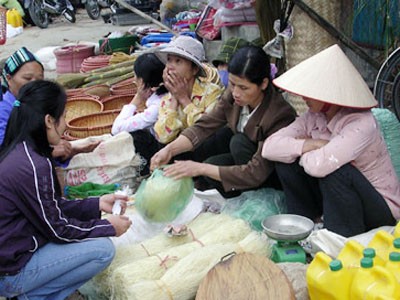 |
Rural market will be one of criteria to be adjusted in the near future
(Photot taken in Haa An District in Cao Bang province). |
(VOVworld) – In 3 years, the new rural development program has changed many rural areas across Vietnam, but the program has revealed some problems that have reduced its effectiveness and kept some rural people from benefiting much. Some adjustment of the criteria is needed to help the new rural development program reach its maximum effectiveness. VOV’s To Tuan has you more details.
In April, 2009, the Vietnamese Government issued a set of criteria for the national new rural development target program in order to boost the country’s industrialization and modernization. Each of the 19 criteria sets detailed norms for each province. Three years later, many rural areas have improved local people’s living conditions, but the program has taken many miss-steps. Song Phuong, an outlying district of Hanoi is a case in point. Although it has fulfilled 16 of the program’s 19 criteria, the designs for new markets and community houses are inappropriate to the local needs. For instance, Thu Que market in Song Phuong Commune was completed last year, but few local people shop there. Song Phuong residents are used to trading along local roads, which they say is more convenient. Nguyen Thi Hoi, a small trader in the market, says ‘At first, local traders sold goods in the new, regulated market place. But when few shoppers went to the market, the traders moved out to the roadways leading to and from the market’.
The community house looks spacious but, according the manager, it isn’t never suited to local customs and community activities. Bui Van Duc, Chairman of Song Phuong’s People’s Committee, says ‘This is a new model and in the initial period of implementation, we faced a lot of difficulties in terms of the awareness, the role, and the involvement of local people. Work that is part of the new rural development program should be done by the locals so they can contribute their ideas’.
Hanoi’s Agriculture and Rural Development Department reports that this year three of Hanoi’s villages are likely to fulfill all 19 criteria of the program. But this is just 3 out of a total of 400 communes that are carrying out the program. Dao Duy Tam, Deputy Director of Hanoi’s Agriculture and Rural Development Department, says much of the works done in fulfillment of the new rural development criteria doesn’t really serve the locals. Tam adds that ‘We now recognize the problem. We should focus not just on the construction of roads, water supply systems, and agricultural machinery, but also on improving quality’.
Since the program was launched 3 years ago and implemented in 9,000 communes nationwide, the Ministry of Agriculture and Rural Development has proposed adjustments to at least 5 criteria, including the norm for labor structure. According to the original norm, a rural commune should have less than 30% of its workets in the agricultural sector. This figure is unrealistic for remote and disadvantaged areas and areas which specialize in farming. A new standard commune should have a per-capita income of more than 1,000 USD per year, which is higher than the average income of most rural areas throughout the country. Nguyen Dang Khoa, Deputy Minister of Agriculture and Rural Development, says ‘The proposed adjustments aim to deal with problems and inconsistencies, not simply to reduce the scope of each criterion. The changes don’t affect the program’s central goals’.
Initial experiences show that good communication, consensus among local authorities and people, and internal strength – not state budget support - are the key factors in new rural development.